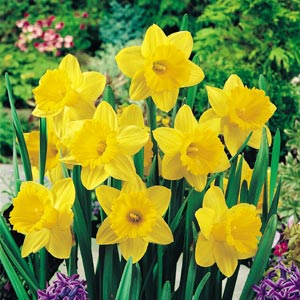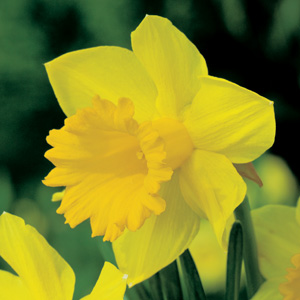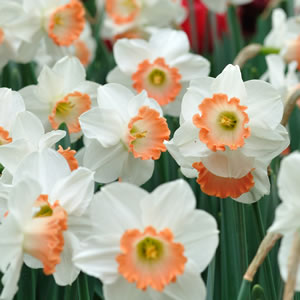Daffodil Growing Tips
How should you plant daffodils?
Make the most of your Daffodils with these handy Daffodil Growing Tips. Daffodils enjoy well-drained soil with slopes and raised beds being preferred. Add well-rotted compost or similar soil conditioning to heavier soils to improve drainage. The slightly acidic soil is best. Bulbs can be planted using the usual guideline of the top of the bulb being twice the height of the bulb below the surface but they are fairly adaptable. In warm climates plant up to double the recommended depth. Also, bulbs in sandy soil can be planted slightly deeper than those in heavy soils. Daffodils will generally only flower from round mature bulbs. If you plant them too shallow they are prone to split up into side-bulbs too readily to reach maturity. Deeper planted bulbs appear to stay healthier, and split less frequently, thus producing more flowers for many years.
Daffodils generally have the best visual appeal when planted in clumps rather than in rows, the larger the clump the better the effect. When planted in pots, daffodils need not be planted as deep as those in the ground but should be covered.
By selecting different varieties you can achieve a longer display as some varieties (eg Jonquil Paperwhite) flower in late Winter/early Spring, others such as yellow trumpet a bit later and others are quite a few weeks later (eg many doubles such as Sir Winston Churchill). Choosing several with different flowering times in clumps near each other, or planting mixed daffodils will extend the enjoyment of their display (this explains why some novice gardeners think their mix isn’t very mixed when the bulbs first start flowering!!). Fancy Daffodils are easy to grow and Garden Express varieties have been selected as most suitable for Australian gardens, however, they perform best in areas with cooler winters.
Do you have to lift the bulbs every year?
It is not necessary to lift daffodils every year, probably every three years is enough. The best guide is that if a clump is not flowering very well, that is if flowers are becoming fewer and fewer, this means that the clump has become too crowded. You should definitely lift and divide them, splitting these bulbs up so they get a new lease of life.
How do you store bulbs?
When you lift daffodil bulbs put them into an open mesh bag like an onion or orange bag and hang in a cool airy spot. (Take care if they are kept in the garage or garden shed, as these can sometimes become quite hot during Summer; a cupboard in the laundry or even the kitchen pantry is a good spot if those areas become quite hot but make sure they are clearly labelled that they are not for eating.) Keep them there until it is the time to plant them in the garden- any time from late March through till late May is suitable; once the heat of Summer is well and truly over and the soil has had a chance to cool down. Refrigeration of daffodils is not necessary for normal flowering.
Is it really necessary to wait until the leaves have died down before you lift the bulbs?
Daffodils can remain undisturbed for many years but need to be lifted once they become crowded and flowering is reduced. If you understand the way a bulb works you will realise the importance of allowing the leaves to wither before you do anything with the bulbs. After a bulb has put out its flowers it will have shrunk to a tiny size, so if it is to flower next season it will need to be replenished with food in the form of starch. This is the purpose of the leaves, making food to build up the bulb to a decent flowering size. If you cut or mow down the leaves too early the bulb will not have grown enough. Although tying the leaves together makes them tidier while they die down, this reduces the amount of light they receive and can reduce their effectiveness in feeding the bulb. Once lifted, store bulbs in a cool, dry, airy place.
Regularly removing the spent flower heads is beneficial to next year’s flowering as the daffodil does not put energy into seed production. Six to eight weeks after flowering has finished you can certainly cut off the withering leaves.
What about feeding bulbs?
To build up a healthy bulb for flowering next season it is a good idea to spread around a well-balanced fertiliser. Use a complete fertiliser, not one that contains only nitrogen as this will lead to all leaf growth. A balanced fertiliser with a ratio of NPK 6:6:6 or an azalea or camellia food will be fine. The best time to feed is just as the flowering is finishing and well before the leaves begin dying off. It is particularly important to feed daffodils planted in pots regularly after flowering to ensure healthy bulb for the following year.
What about watering?
Natural rainfall should suffice in many areas, however, keep bulbs moist during dry spells in autumn and late spring.
![]()









